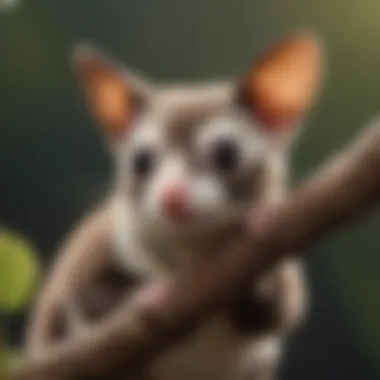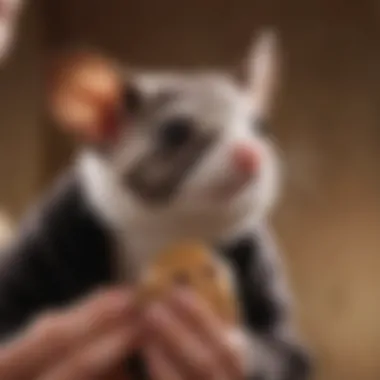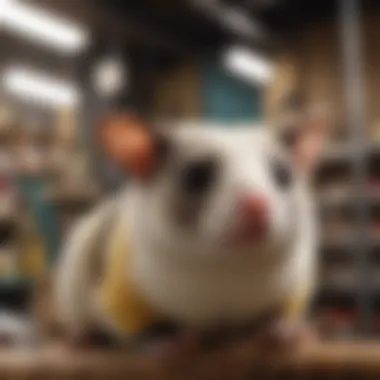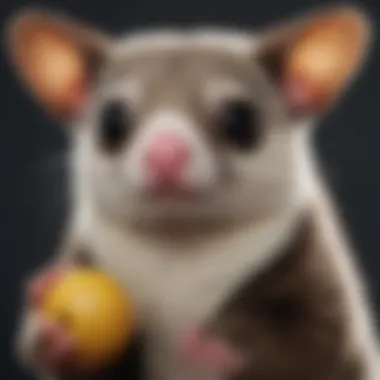Where to Buy Sugar Gliders: A Complete Guide


Intro
Purchasing a pet sugar glider is a nuanced endeavor that calls for consideration of multiple factors. Sugar gliders are unique creatures that blend cuteness with distinct care requirements. If you are exploring the idea of bringing one into your life, it is crucial to understand whereto source these animals. The process involves understanding the role of reputable breeders, validations through adoptable sources, choices presented at pet stores, and the rise of online platforms offering sugar gliders for sale. Each option carries its own implications pertaining to animal welfare, legal confines, and what responsible ownership entails.
Care Tips
Caring for a sugar glider goes beyond simply providing food and shelter. A proper arrangement encompassing attentive daily care is fundamental for a happy coexistence with your new pet.
Daily Care Routines
Sugar gliders are nocturnal animals; they are most active at night. Feeding them at these peak times proves vital for their health. Include about a tablespoon of fresh fruits or vegetables along with specially formulated sugar glider food. It is also beneficial to engage in daily play to strengthen your bond and stimulate their minds. Also check that their cage remains occupied with a stimulating environment, ensuring regular interaction.
Cage Setup and Maintenance
The cage is an often overlooked, yet critical aspect in sugar glider maintenance. The ideally-sized cage should offer enough horizontal space for jumping and climbing. Wire cages that offer good ventilation are a suitable choice. Make sure to clean the cage regularly, removing uneaten food and other waste promptly to maintain hygiene. Strong, stable branches, nutrient-rich toys, and hiding spots can help create a more enriching habitat.
Hygiene and Cleaning Practices
Cleanliness is essential not just for preventing odor but also for maintaining the animal’s health. Engage in a regimen where you clean perches and bedding at least once a week using pet-safe cleaners. Ensure that any glass containers used for food are also sanitized. Additionally, frequent spot checks to get rid of any waste are crucial.
Seasonal Care Adjustments
Sugar gliders may require different care routines depending on seasonal temperature variations. In the colder months, ensure their habitat remains warm and cozy, setting heat pads if necessary. On hotter days, take steps to ensure an excellent ventilation system, perhaps incorporating cooling pads or fan use, all while avoiding direct sunlight exposure.
Behavioral Insights
To nurture your relationship with your sugar glider, understanding their behavior is paramount. Familiarizing yourself with their communication signals provides insight into their emotional state and needs.
Understanding Sugar Glider Body Language
Observe your pet carefully. Signs like chattering, vocalizations, and tail movements reveal how they feel. A relaxed glider will often be engaged, but defensive behaviors like puffing up may indicate stress or discomfort.
Common Behavioral Issues and Solutions
When adapting to a new home, be prepared for typical behavioral issues like biting or hiding. Giving them adequate time to adjust while establishing boundaries will speed up acclimatization. Paths drawn between rigorous interaction and consistent routines help dissolve many initial issues.
Positive Reinforcement Techniques
Using positive reinforcement is powerful when training sugar gliders. Successful behaviors should be awarded with praises or small treats during and after training sessions. Avoid punishments as they often damage trust.
Social Interaction Needs
Sugar gliders are very social animals. If they feel isolated, they may become stressed and shine, affecting their general health. Therefore, multiple sugar gliders or consistent interaction with their human counterparts is advisable.
Nutrition Guides
Keeping sugar gliders healthy matters a lot with regards to their diet. Understanding nutritional requirements ensures longevity and vitality in these exotic pets.
Essential Diet Components
Apart from formulations meant for sugar gliders, a balanced mix of fruits, insects, and vegetables pairs well. Key ingredients like fruits high in vitamin C play an integral role in strengthening the immune system.
Safe and Toxic Foods
Awareness is crucial. Certain foods like chocolate and high-fat items like avocado should strictly be avoided. Making informed choices regarding safe options enhances your pet’s life expectancy.
Supplements and Treats
Consider adding calcium supplements owingto the likelihood of calcium deficiency. However, be cautious- consult a veterinarian beforehand to ensure the correctness of choices you make.
Feeding Strategies for Different Species
Different species of sugar gliders have varying needs. Monitor other recommendations pertaining to species specifics relating to both nutritional habits and dietary preferences.
Wellness and Health
Awareness about their well-being plays a critical role in ensuring overall happiness. Begin routine health check-ups immediately once you get ownership.
Routine Health Checkups


Regular veterinary visits will help delete potential healthissues early. A proper follow-up schedule aids in tracking wellness throughout their lives.
Identifying Symptoms of Illness
Minor signs ranging from lethargy to changes in appetite should alert the owner. Take special note of more profound changes, such as nasal discharge or sneezing.
Preventative Care and Vaccinations
Consult with experts about setting up vaccination schedules. Keeping preventative care in sight minimizes unwanted health concerns.
Mental and Emotional Well-being
Addressing both mind and spirit enhances every interaction. Getting toys that stimulate their curiosity helps loop positive feelings around proper care.
Enriching Activities
Sugar gliders thrive on routine and activities. Apart from what is outlined above, there are ample engaging activities.
Toys and Playtime Ideas
Invest in chew toys specially designed for small animals, allowing them to stimulate mentally. Create toy rotations with diverse items to sustain high levels of interest from your pet.
Training and Tricks
Mobilizing off easily-trained components like moving items or retrieving is common. It sharpens both memory and relationship cell.
Outdoor Activities and Interaction
If feasible, allow for supervised outdoor activities enhancing interactive fun. Ensure a safe environment, keeping in mind the hazards that might exist.
DIY Projects for Mental Stimulation
Create simple DIY projects that aid in developing mental functions. Examples include hiding food in easy-to-find places to encourage natural behaviors.
Your sugar glider is more than just a pet. Invest time in learning about their care and behavior to create a fulfilling experience for both you and your new companion.
By informing yourself on these points, you position yourself as a responsible potential sugar glider owner.
Now, consider this the beginning of your journey to creating an overall better environment for both you and the unique creature sharing your home.
Intro to Sugar Gliders
Sugar gliders are becoming more popular as pets. Understanding them is essential for any potential owner. In this section, we explore critical aspects like their nature and legal concerns. This knowledge helps make informed decisions when considering adding one to your household.
Understanding Sugar Gliders as Pets
Sugar gliders are small, nocturnal marsupials native to Australia and New Guinea. They are known for their charming personalities and social nature. As pets, they require a significant commitment. Their playful demeanor and ability to bond with owners make them endearing companions. However, potential owners must be prepared for the necessities of their care.
These creatures thrive in social atmospheres, so they often benefit from living in pairs. They have specific habitat preferences and dietary needs. It's crucial to replicate as much as their natural environment as possible to keep them healthy and happy. Furthermore, potential owners should research their habitual behavior. This understanding can lead to better interactions and strengthening the bond with your pet.
Legal Considerations for Ownership
In many regions, owning a sugar glider may come with legal stipulations. Depending on where the buyer resides, some localities impose regulations on exotic pets. Certain areas may require permits or prohibit ownership outright. Examining legal boundaries is vital before committing to such a significant responsibility.
Additionally, understanding animal welfare laws in your area is necessary. Local guidelines often dictate housing standards and veterinary care. Being aware of these legal considerations is important in promoting a safe and compliant ownership experience for sugar glider households.
Always check local government guidelines and consult professionals before adopting a sugar glider to ensure a lawful and supportive environment.
Where to Buy Sugar Gliders
Knowing where to buy sugar gliders is crucial. Potential owners need to understand the sources that provide healthy, ethically treated animals. The right source impacts not only the pet's health but also affects the future relationship between the owner and the pet. This section discusses several purchasing options including reputable breeders, pet stores, and online platforms. Each option has its merits but also requires careful consideration due to various factors such as animal welfare, legality, and reliable practices.
Reputable Breeders
Reputable breeders are often seen as the best choice for acquiring a sugar glider. These individuals prioritize the health of their animals and understand the specific care these pets require.
Identifying Trusted Breeders
Identifying trusted breeders involves research. Look for breeders who have positive reviews and are registered with recognized sugar glider clubs. A key characteristic of these breeders is their transparency. They usually provide information about their breeding practices and the specific lineage of the animals.
One unique feature of utilizing reputable breeders is the opportunity for buyers to meet the animals before making a purchase. This helps in forming an early bond with the pet. The disadvantage could be that reputable breeders might have a long waiting list or their costs can be higher than local pet stores.


Visiting Breeding Facilities
Visiting breeding facilities offers hands-on insights into the conditions in which the sugar gliders are raised. It allows prospective owners to evaluate the space, cleanliness and overall care the animals receive. A critical characteristic here is the ambiance. A positive environment indicates healthy, well-adjusted sugar gliders.
The unique advantage of visiting these facilities is the chance to speak directly with breeders about care recommendations and behavior insights. However, not all breeders welcome visits, which can create distrust among buyers.
Pet Stores
Pet stores represent a more accessible option for many. They provide the chance to quickly purchase a sugar glider without waiting periods. Pet.store employees may also offer valuable care information. However, not all stores provide the same standard of care.
Evaluating Local Pet Stores
Evaluating local pet stores is important before deciding on a purchase. Look for signs that suggest animals are well cared for — clean cages, social animals and knowledgeable staff reflect quality care.
A notable feature of buying from local pet stores is the immediacy of the transaction. Customers can purchase their new pet right away. Of course, local pet stores sometimes lack thorough history regarding the health and background of their animals, which can be a serious drawback.
Understanding Pet Store Practices
Understanding pet store practices allows potential buyers to make informed decisions. Stores differ in their animal sourcing and care - understanding these practices educates consumers on possible risks involved. Many reputable stores source from individual breeders emphasizing health, while others might deal with mass suppliers that may prioritize profit over care.
This understanding is beneficial for anyone considering buying a sugar glider, as it outlines potential points of concern regarding the ethical aspects of animal care. At times, it can be hard to obtain specific health information about the pet being purchased.
Online Platforms
Online platforms offer buyers a vast pool of options, sometimes at more competitive prices. It increases the potential sources available to find the perfect sugar glider.
Finding Legitimate Online Sellers
Finding legitimate online sellers is key to a safe purchase. Look for sellers with established reputations, active customer feedback, and detailed descriptions of their animals. Safety in buying online stems from seller transparency and buyer reviews.
The main advantage here is broader access to experienced breeders from various regions. A drawback often faces buyers, though — animals are shipped rather than personally observed. It diminishes the experience and carries implicit delivery risks.
Assessing Shipping and Delivery Policies
Assessing shipping and delivery policies involves looking at how sellers handle the dispatch of animals. Ensure that the seller takes appropriate measures to guarantee animals' health and safety during transit.
Reputable online platforms outline their policies clearly, offering detailed accounts of the shipping process and any related guarantees or necessary steps like vaccination. The favorable aspect is how compliance-oriented sellers will often prioritize pet welfare. The negative aspect happens if any procedural detail is overlooked during shipping, possibly leading to distressing circumstances for the animal.
For anyone buying a sugar glider, careful groundwork iis essential; the clarity and wellness of animals should alwasy remain a priority.
Factors to Consider When Purchasing Sugar Gliders
Purchasing a sugar glider requires careful consideration of multiple factors. These factors ensure that the decision supports both the buyers and the welfare of the animal. As exotic pets, sugar gliders have challenges unique to them. Understanding these challenges, including costs and health assessments, is essential for a successful ownership experience.
Cost Implications
Initial Purchase Costs
Initial purchase prices for sugar gliders can vary significantly based on several factors. These include the breeder, lineage, age, and geographic location. Most, however, can expect to pay anywhere from $100 to $500 per sugar glider. It is a key characteristic for potential purchasers to understand that this cost does not include what you will need later on.
The benefit of knowing the initial price lies in being able to budget effectively. Buyers should prioritize reputable sources, as this often ensures healthier animals that are not obtained from unethical practices. Initial purchase costs establish the framework for upcoming expenses in your care journey, making it a pivotal factor in this undertaking.
Other unique considerations about initial costs include potential higher prices for certain color variations and patterns. Often, more unusual colorations can demand higher prices. Considering hybrid owners or breeders can also impact these initial expenses.
Long-term Care Expenses
Long-term care demands extend beyond the initial purchase amount. Owners can expect monthly expenses for food, cage setup, and healthcare, adding to the overall investment in the animal's well-being. A quality diet specifically formulated for sugar gliders can cost upward of $20 per month. Moreover, regular vet checks are vital, presenting another financial commitment that might go overlooked initially.
These ongoing costs are significantly crucial for assessing whether a prospective owner is prepared for the full responsibilities of pet ownership. A unique aspect of long-term care expenses is the need for specialized products, including toys and habitat configurations tailored to sugar glider interests.
Investing in durable and safe accessories can enhance well-being, countering other expenses that could emerge should health issues arise from inappropriate care. Identifying potential costs early is valuable when ensuring long-term success and satisfaction.
Health Assessments
Recognizing Signs of Illness
Understanding how to recognize signs of sickness is vital for sugar glider owners. This kind of knowledge allows for timely intervention in case health complications arise. Common indicators include changes in behavior, uneaten food, or a significant drop in activity level.
Education around these signs enhances responsible pet ownership. Closely monitoring your pet will help establish baseline behavior patterns, making it easier to spot deviations. Recognizing such signals acts not only to protect the animal but can improve a owner’s proficiency in sugar glider care overall.


Requesting Health Records
Securing health records from the seller or breeder before purchase is essential. These documents represent more than just information; they establish a backing for the future ownership and indicate any pre-existing medical conditions or previous veterinary visits. Having access to this information helps prepare for proper ongoing care. It relieves uncertainty of the primary physical status of sugar gliders during the acquisition phase.
A seller that willingly provides such logs often indicates a trustworthy practice. This assurance is essential, establishing trust between the buyer and the seller while fostering transparent, responsible animal ownership. Ensuring clear and honest communication at the outset improves the overall experience immensely.
Understanding these fundamental factors can significantly impact the beginning of your journey as a responsible sugar glider owner. Having equipped yourself ahead of time forms a solid foundation for a fulfilling companionship.
Post-Purchase Considerations
Post-purchase considerations are crucial when bringing a sugar glider into your home. This phase goes beyond the purchase itself and involves responsibilities and guarantees to ensure a healthy and happy life for your pet. Failure to address these considerations may diminish the overall satisfaction and emotional reward associated with sugar glider ownership. Hence, understanding what this entails is paramount.
Creating a Suitable Habitat
Creating a suitable habitat for your sugar glider requires both thoughtfulness and strategy. Sugar gliders are active and social creatures, so providing an environment that emulates their natural habitat is essential. A spacious cage is non-negotiable. The minimum recommended size is at least 24x24x48 inches. Higher cages are better since these animals enjoy jumping and gliding; vertical space is as important as horizontal space.
Inside the cage, include appropriate accessories such as climbing branches, hammocks, and hiding spots to allow them to explore and feel secure. Lacing the cage with soft, non-toxic bedding ensures a comfortable sleep area. Also, consider placing items like exercise wheels and chew toys to keep them entertained and active.
Maintaining compatible temperature and humidity levels is also vital. Sugar gliders thrive at around 70-90°F and thus do best in a climate-controlled environment, away from drafts and extremes. Regularly checking for cleanliness is essential, as sugary gliders are prone to respiratory diseases if exposed to unsanitary conditions. Ensuring lamps for specialized lighting during the day can mimic their natural day-night cycle.
Nutrition and Diet
Nutrition is equally vital for your sugar glider’s health and longevity. These animals have a specialized diet that includes various foods. Although they enjoy fruits and nectar, they require a balanced diet that includes proteins. High-quality commercial pellets designed for sugar gliders serve as a good base. These pellets provide necessary vitamins and minerals daily.
Fruits should account for no more than 20% of their diet. Suitable fruits include apples, berries, and bananas. Fresh leafy vegetables can also play a role, but only in moderation. Likewise, protein sources like crickets, mealworms, and cooked chicken can be great additions. Always avoid avocados and chocolate, as these can be toxic.
Hydration is paramount. Fresh, clean water should be available at all times. Some sugar glider owners use water bottles fitted with sipper tubes, while others choose bowls. Whichever method you select, ensure it is cleaned often.
Remember that improper nutrition can lead to health issues, such as obesity and metabolic disorders. Providing variety and balanced nutrition can ensure a long and healthy life.
In summary, understanding post-purchase factors for sugar gliders emphasizes the care involved in ensuring that these pets thrive in your home. An appropriately designed habitat paired with a wholesome diet forms the basis of responsible ownership. As you prepare to welcome a sugar glider, consider these elements with the attention they deserve.
Common Challenges in Sugar Glider Ownership
Understanding the common challenges in sugar glider ownership is essential for anyone considering these enchanting creatures as pets. Sugar gliders are exotic animals and have unique needs and behaviors that potential owners must take into account. This section addresses the key concerns that can affect the bond you create with your sugar glider, along with potential behaviors to watch for.
Bonding with Your Sugar Glider
Bonding with your sugar glider is crucial to forming a strong relationship. This process involves trust and comfort. Patience is essential, as these animals can be cautious newcomers to human interactions. Giving them time to acclimate is important. Start with gentle movements and speaking softly to your sugar glider. Gradually introduce your scent by handling items they use, such as bedding or toys.
To facilitate bonding, you can handle your sugar glider daily. Initiating short sessions of interaction will help calmer fears. Offering treats, like small pieces of fruits or insects, can create a positive connection between you. Additionally, exposing them to various environments within your home while ensuring that they feel safe also aids in comfort.
- Provide a Secure Environment: Use a spacious cage with plenty of places to hide and explore. This will give them comfort and reduce stress.
- Gradual Changes: Sudden changes in their habitat or routine might provoke anxiety. Proceed slowly to help them adjust comfortably.
- Consistency: Establish a consistent routine for feeding and playtime. Predictability builds reassurance.
Remember, a well-bonded sugar glider is generally happier and healthier, both emotionally and physically.
Understanding Sugar Glider Behavior
To comprehend your sugar glider better, familiarize yourself with their specific behavioral traits. Knowing what is normal for them can help detect any signs of stress or health concerns. Sugar gliders have active periods, primarily at night. This means they will naturally want play and interaction during these times.
Observe for common behaviors such as:
- Gliding: This behavior is natural; it’s how they see their environment and explore.
- Vocalizations: Sugar gliders communicate through various sounds. Chattering can signify happiness, while distress calls often indicate discomfort or anxiety.
- Grooming: Grooming habits are significant. Grooming each other reflects social bonds. In contrast, over-grooming can point to stress or boredom—understanding this distinction is vital.
Recognizing these signs goes a long way. Owners who are in tune with their pet's behaviors can quickly identify issues and act before they escalate. Take the time to learn directly from your sugar glider.
Exploring their behaviors will aid your bond while reducing stress throughout their life with you. Continuous education on their needs often separates responsible and informal pet ownership paths. Be committed, and your sugar glider will thrive.
Closure
In this article, we have explored the various avenues through which one can purchase a sugar glider. The topic of where to acquire these exotic pets is not only about choice, but also about responsibility and informed decisions. Understanding the welfare and legality surrounding sugar gliders ensures that potential owners make choices that are not only feasible but also ethical.
Summary of Key Points
When considering the acquisition of a sugar glider, several essential points should resonate with potential owners:
- Sources of Acquisition: Sugar gliders can be sourced from reputable breeders, pet stores, or online platforms. Each option carries its own set of advantages and challenges.
- Health and Care Considerations: Understanding the health implications upon purchase helps new owners not only avoid potential vet costs but also ensures a humane start for the pet.
- Proper Environment: Creating a suitable habitat is crucial for encouraging natural behavior and overall happiness in sugar gliders.
- Long-term Commitment: Ownership entails ongoing commitment, including feeding, social interaction, and medical care.
These points underscore the significance of deliberate choices when pursuing sugar glider ownership.
Final Thoughts on Responsible Ownership
As one anticipates welcoming a sugar glider into their home, it is imperative to embrace the broader responsibilities of pet ownership. These includes:
- Continuous Learning: Being proactive about understanding sugar glider behavior aids in forging a strong bond with the pet.
- Community Engagement: Engaging with other sugar glider owners, whether through social media or local groups on platforms like Facebook and Reddit, can provide support and insight.
- Preparedness: Ensuring one has the resources and commitment necessary from day one is vital for a harmonious relationship.
Recent studies and content found on Wikipedia and Britannica can further inform prospective sugar glider owners, fostering a deeper understanding of responsbile care practices. Overall, these final thoughts emphasize that while acquiring a sugar glider may seem straightforward, the underlying commitments should influence one’s decision profoundly.















